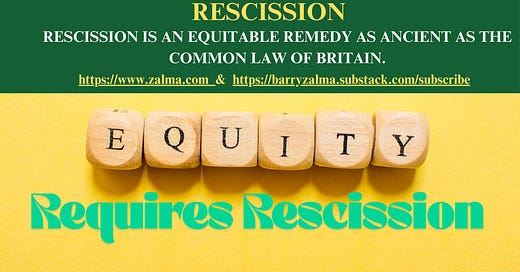If you are not a subscriber you’re reading a portion of the full article on the free version of Excellence in Claims Handling and should consider joining as a paid member to get full access to articles for members only, to our news, analysis, insurance coverage, claims, insurance fraud and insurance webinars, by clicking at the button below.
When the United States was conceived in 1776 and1789 the founders were concerned with protecting their rights under British common law. They adopted it as the law of the new United States of America modified only by the limitations placed on the central government by the U.S. Constitution approved in 1789.
The viability and ability to enforce contracts was recognized as essential to commerce. Courts of law were charged with enforcing legitimate contracts. Courts of equity were charged with protecting contracting parties from mistake, fraud, misrepresentation and concealment since enforcing a contract based on mistake, fraud, misrepresentation or concealment would not be fair.” [ Barry Zalma, Rescission of Insurance – 2nd Edition]
The common law developed rules that courts could follow to refuse to enforce the terms of a contract that was entered into because of mutual mistake of material fact, a unilateral mistake of material fact, the breach of warranty (a presumptively material promise to do or not do something), a material concealment, or a material misrepresentation. “The remedy – called rescission – created a method to apply fairness to the insurance contract and allow an insurer to void a contract and allowed courts to refuse to enforce such a contract entered into by misrepresentation or concealment of material facts.” [Barry Zalma, The Equitable Remedy of Rescission, LexisNexis Legal Newsroom Insurance Law, (April 21, 2015), https://www.lexisnexis.com/legalnewsroom/insurance/b/insurancelaw/archive/2015/04/21/the-equitable-remedy-of-rescission-a-tool-to-defeat-fraud.aspx?Redirected=true - See more at: https://searchenginereports.net/matchtext.]
Some plaintiffs’ lawyers contend that rescission is “post loss underwriting” rather than the exercise of a legitimate equitable remedy as old as the common law. In California, one of the biggest proponents of the theory failed to overturn a legitimate rescission in Nieto v. Blue Shield of California Life & Health Insurance Co., No. B214669 (Cal.App. Dist.2 01/19/2010), proving that it is not only not nice to lie to your insurance company, it is fatal.
Under applicable New Jersey law, the designation of Great American's post-claim investigation as post-loss underwriting does not serve, either alone or in conjunction with the flawed underwriting on the 1999 and 2000 renewals, to defeat Great American's reasonable reliance on the insured's applications. [In re Tri-State Armored Services, Inc., 332 B.R. 690 (Bankr. N.J. 2005)
Rescission is an important equitable remedy hoary with age and should not be limited by claims of bad faith after an insurer legitimately exercises the rights provided to parties to an insurance contract by the California Insurance Code. If, after completing the thorough investigation required by law, the investigator finds that the application misrepresented what appears to be a material fact or material facts or concealed a material fact or material facts, the investigation is not complete.
An insured's material misrepresentation or omission of fact in the procurement of insurance can render the insured's coverage voidable at the insurance company's option because there can be no "meeting of the minds" as to the insured risk. [Foster v. Auto-Owners Ins., Co., 703 N.E.2d 657, 659 (Ind. 1998); see also Colonial Penn Ins. Co. v. Guzorek, 690 N.E.2d 664, 672 (Ind. 1997) Med. Protective Co. of Fort Wayne Ind. v. Am. Int'l Specialty Lines Ins. Co. (N.D. Ind., 2019)]
An insurer seeking to rescind a policy must fulfill the basic rule that a party seeking rescission must "first make a tender of the full amount of premiums paid under the policy." [Am. Std. Ins. Co. v. Durham, 403 N.E.2d 879, 881 (Ind. Ct. App. 1980)].
Governing law permits an insurer to rescind a policy when the insured has misrepresented or concealed material information in connection with obtaining insurance. (TIG Ins. Co. of Michigan v. Homestore, Inc. (2006) 137 Cal.App.4th 749, 755-756.) According to Mitchell v. United National Ins. Co. (2005) 127 Cal.App.4th 457, 468 (Mitchell), the Insurance Code provides a “statutory framework that imposes ‘heavy burdens of disclosure’ ‘upon both parties to a contract of insurance, and any material misrepresentation or the failure, whether intentional or unintentional, to provide requested information permits rescission of the policy by the injured party.’ [Citation.]”
Discussing the purpose of the statutory scheme, the Court stated:
“Requiring full disclosure at the inception of the insurance contract and granting a statutory right to rescind based on concealment or material misrepresentation at that time safeguard the parties’ freedom to contract.
‘[An insurance company] has the unquestioned right to select those whom it will insure and to rely upon him who would be insured for such information as it desires as a basis for its determination to the end that a wise discrimination may be exercised in selecting its risks.’
The thorough investigator must meet with the underwriter who made the decision to insure the insured to determine the effect a truthful answer would have had on the underwriting decision. The claims person should ask the underwriter, with regard to the misrepresented or concealed facts, the following questions:
· If you had known the truth would you have agreed to the insurance?
· If you had known the truth would you have agreed to the insurance at the same premium?
· If you had known the truth would you have agreed to the insurance on the same terms and conditions?
A negative response to any one of the questions will be evidence of “materiality” which is defined by the California Insurance Code § 334 as:
Materiality is to be determined not by the event, but solely by the probable and reasonable influence of the facts upon the party to whom the communication is due, in forming his estimate of the disadvantages of the proposed contract, or in making his inquiries.
Before making a decision to rescind, the claims investigator and the insurer should seek the advice of competent insurance coverage counsel for an opinion based upon the investigation and the law of the jurisdiction where the policy was made or where it was made to be performed, and, if counsel believes it necessary, the examination under oath of the insured.







